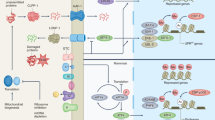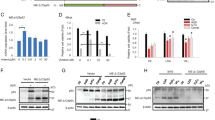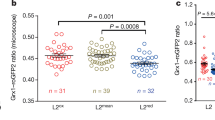Abstract
Correlative evidence links stress, accumulation of oxidative cellular damage and ageing in lower organisms and in mammals. We investigated their mechanistic connections in p66Shc knockout mice, which are characterized by increased resistance to oxidative stress and extended life span. We report that p66Shc acts as a downstream target of the tumour suppressor p53 and is indispensable for the ability of stress-activated p53 to induce elevation of intracellular oxidants, cytochrome c release and apoptosis. Other functions of p53 are not influenced by p66Shc expression. In basal conditions, p66Shc−/− and p53−/− cells have reduced amounts of intracellular oxidants and oxidation-damaged DNA. We propose that steady-state levels of intracellular oxidants and oxidative damage are genetically determined and regulated by a stress-induced signal transduction pathway involving p53 and p66Shc.
This is a preview of subscription content, access via your institution
Access options
Subscribe to this journal
Receive 50 print issues and online access
$259.00 per year
only $5.18 per issue
Buy this article
- Purchase on Springer Link
- Instant access to full article PDF
Prices may be subject to local taxes which are calculated during checkout





Similar content being viewed by others
References
Ames BN, Shigenaga MK, Hagen TM . 1993 Proc. Natl. Acad. Sci. USA 90: 7915–7922
Bladier C, Wolvetang EJ, Hutchinson P, de Haan JB, Kola . 1997 Cell. Growth Differ. 8: 589–598
Cattaneo E, Pelicci PG . 1998 Trends Neurosci. 21: 476–481
Finkel T, Holbrook NJ . 2000 Nature 408: 239–247
Gniadecki R, Thorn T, Vicanova J, Petersen A, Wulf HC . 2000 J. Cell. Biochem. 80: 216–222
Green DR, Reed JC . 1998 Science 28: 1309–1312
Guarente L, Kenyon C . 2000 Nature 408: 255–262
Harman D . 1981 Proc. Natl. Acad. Sci. USA 78: 7124–7128
Helbock HJ, Beckman KB, Ames BN . 1999 Methods Enzymol. 300: 156–166
Johnson TM, Yu ZX, Ferrans VJ, Lowenstein RA, Finkel T . 1996 Proc. Natl. Acad. Sci. USA 93: 11848–11852
Kirkwood TB, Austad SN . 2000 Nature 408: 233–238
Lambeth JD, Cheng G, Arnold RS, Edens WA . 2000 Trends Biochem. Sci. 25: 459–461
Li PF, Dietz R, von Harsdorf R . 1999 EMBO J. 18: 6027–6036
Melov S, Ravenscroft J, Malik S, Gill MS, Walker DW, Clayton PE, Wallace DC, Malfroy B, Doctrow SR, Lithgow GJ . 2000 Science 289: 1567–1569
Migliaccio E, Mele S, Salcini AE, Pelicci G, Lai KM, Superti-Furga G, Pawson T, Di Fiore PP, Lanfrancone L, Pelicci PG . 1997 EMBO J. 16: 706–716
Migliaccio E, Giorgio M, Mele S, Pelicci G, Reboldi P, Pandolfi PP, Lanfrancone L, Pelicci PG . 1999 Nature 402: 309–313
Nicolli A, Basso E, Petronilli V, Wenger RM, Bernardi P . 1996 J. Biol. Chem. 271: 2185–2192
Pelicci G, Lanfrancone L, Grignani Fr, McGlade J, Cavallo F, Forni G, Nicoletti I, Grignani F, Pawson T, Pelicci PG . 1992 Cell 70: 93–104
Polyak K, Waldman T, He TC, Kinzler KW, Vogelstein B . 1996 Genes Dev. 10: 1945–1952
Polyak K, Xia Y, Zweier JL, Kinzler KW, Vogelstein B . 1997 Nature 389: 300–305
Purdie CA, Harrison DJ, Peter A, Dobbie L, White S, Howie SE, Salter DM, Bird CC, Wyllie AH, Hooper ML, Clarke AR . 1994 Oncogene 9: 603–609
Schuler M, Bossy-Wetzel E, Goldstein JC, Fitzgerald P, Green DR . 2000 J. Biol. Chem. 275: 7337–7342
Van Remmen H, Richardson A . 2001 Exp. Gerontol. 36: 957–968
Tanhauser SM, Laipis PJ . 1995 J. Biol. Chem. 270: 24769–24775
Tyner SD, Venkatachalam S, Choi J, Jones S, Ghebranious N, Igelmann H, Lu X, Soron G, Cooper B, Brayton C, Hee Park S, Thompson T, Karsenty G, Bradley A, Donehower LA . 2002 Nature 415: 45–53
Yakes FM, Van Houten B . 1997 Proc. Natl. Acad. Sci. USA 94: 514–519
Yin Y, Terauchi Y, Solomon GG, Aizawa S, Rangarajan PN, Yazaki Y, Kadowaki T, Barrett JC . 1998 Nature 391: 707–710
Vogelstein B, Lane D, Levine AJ . 2000 Nature 408: 307–310
Acknowledgements
We thank L Luzi, L Pozzi, K Helin, R Carbone, M Capogrossi, A Cocito and R Cortese for many helpful discussions; G Giardina, G Pelliccia, M Bono, MT Sciurpi, S Ronzoni and M Faretta for technical help; A Ariesi for secretarial work. M Trinei, A Ventura and E Milia are recipient of fellowships from FIRC, VAR from M Curie. Supported by grants from EC, AIRC and CNR.
Author information
Authors and Affiliations
Corresponding authors
Rights and permissions
About this article
Cite this article
Trinei, M., Giorgio, M., Cicalese, A. et al. A p53-p66Shc signalling pathway controls intracellular redox status, levels of oxidation-damaged DNA and oxidative stress-induced apoptosis. Oncogene 21, 3872–3878 (2002). https://doi.org/10.1038/sj.onc.1205513
Received:
Revised:
Accepted:
Published:
Issue Date:
DOI: https://doi.org/10.1038/sj.onc.1205513
Keywords
This article is cited by
-
ROS production by mitochondria: function or dysfunction?
Oncogene (2024)
-
USP15 regulates p66Shc stability associated with Drp1 activation in liver ischemia/reperfusion
Cell Death & Disease (2022)
-
Cross organelle stress response disruption promotes gentamicin-induced proteotoxicity
Cell Death & Disease (2020)
-
Derepression of LOXL4 inhibits liver cancer growth by reactivating compromised p53
Cell Death & Differentiation (2019)
-
Mitochondrial dysfunction and oxidative stress in heart disease
Experimental & Molecular Medicine (2019)



